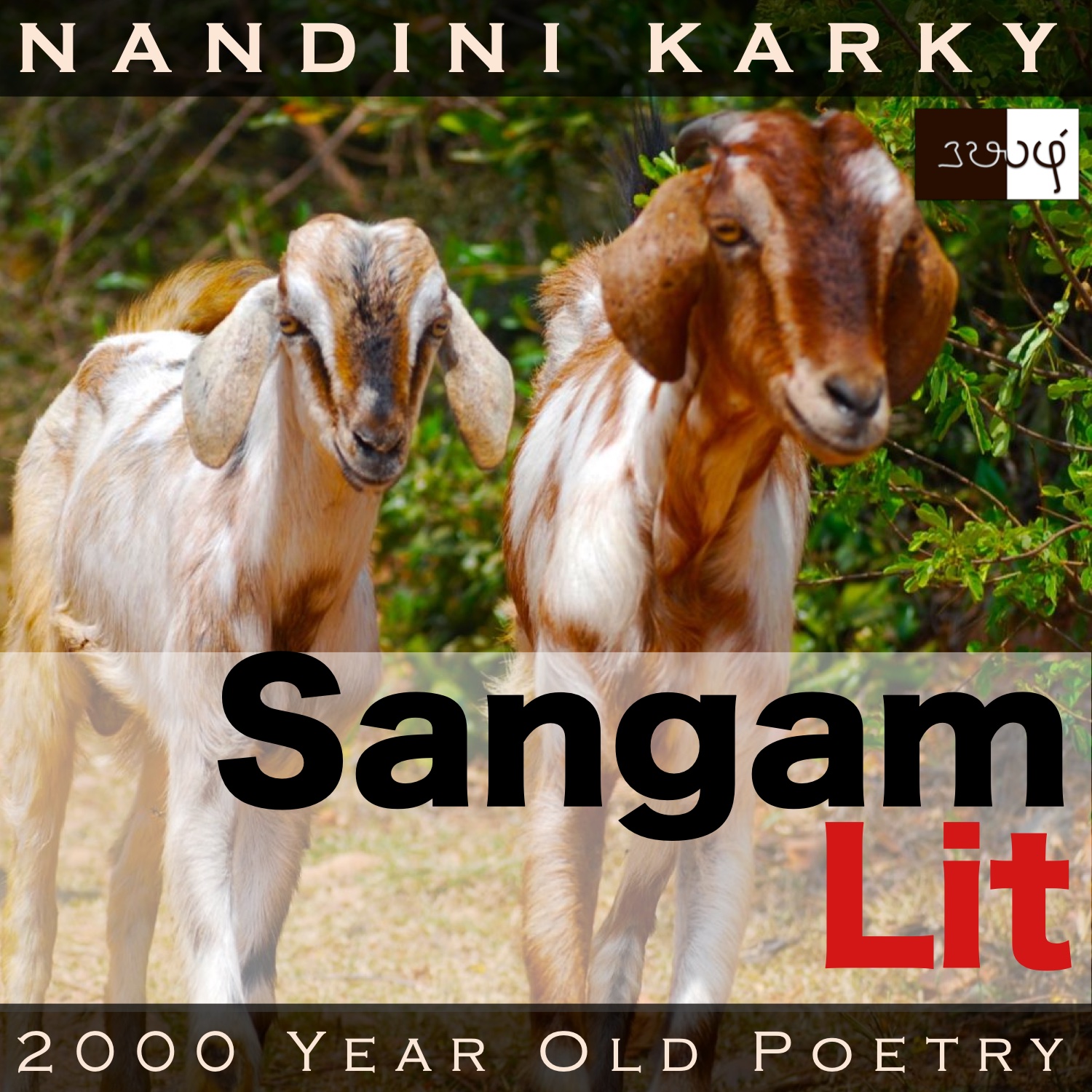Podcast: Play in new window | Download
Subscribe: Apple Podcasts | Spotify | Amazon Music | Android | iHeartRadio | Email | TuneIn | RSS | More

In this episode, we perceive references to the lives of ancient goatherds, as depicted in Sangam Literary work, Kurunthogai 221, penned by Uraiyoor Mudhukotranaar. Set in the forests of ‘Mullai’, the verse speaks in the voice of the lady to the confidante, conveying her angst as the man is delayed beyond his promised season of return.
அவரோ வாரார், முல்லையும் பூத்தன,
பறி உடைக் கையர் மறி இனத்து ஒழியப்
பாலொடு வந்து கூழொடு பெயரும்,
ஆடுடை இடைமகன் சென்னிச்
சூடிய வெல்லாம் சிறுபசு முகையே.
‘Jasmines have bloomed and he still comes not’ is the theme of this verse. The opening words ‘அவரோ வாரார் முல்லையும் பூத்தன’ meaning ‘while he has not returned, the wild jasmines have already blossomed’ declares that oft-repeated thought in Sangam verses from this region. In the phrase ‘பறி உடைக் கையர்’ meaning ‘people, whose hands hold mats made of palmyra leaves’, we can infer an ancient palm weaving industry at work and the widespread market for its products. Likewise, the phrase ‘பாலொடு வந்து கூழொடு பெயரும்’ meaning ‘comes with milk and leaves with rice gruel’ is a significant term detailing the micro-economics in the forest regions, about which we will delve into, shortly. A ‘herder of goat’ strides in ‘ஆடுடை இடைமகன்’. Ending with the words ‘சூடிய வெல்லாம் சிறுபசு முகையே’ meaning ‘what is worn are little, fresh buds’, the verse welcomes us to listen with empathy.
The goatherd mentioned here seems to pass on to the lady, a significant message. The context reveals that the man and lady were leading a happy, married life when the man parted away on a mission. Before he left, he promises the lady that he’d be back before the rains. One day, when the confidante tries to comfort her languishing friend, the lady says to her, “He comes not even when the wild jasmines have bloomed. Carrying a palm-leaf mat in his hand, leaving behind his herd of kids, the goatherd comes with milk and parts with food. What he wears on his head, are the many, little, fresh buds of those flowers!” With these words, the lady expresses her anguish at the man’s delay in returning home.
Time to delve into those nuances in this tiny verse! The lady starts by talking about what’s bothering her and that is the fact the man has not returned even when the wild jasmines have started blooming. As if in reply to the confidante’s question, ‘How would you know the jasmines have bloomed when you have been shut in the house all day?’, the lady describes a person who had visited home. This person seemed to be carrying a palm mat in his hands, and the lady continues by saying how he had left behind his herd of goats to come to their home. When he came, he brought a bowl of milk, and when he left, he had food in his hands, the lady details. But the most important detail was in what he was wearing all over his head and that was nothing but the little buds of wild jasmines, the lady concludes.
There you have it! From where else would the goatherd get the wild jasmine buds and what other sign do you need that the rains are here, the lady seems to ask her friend. Indeed, those flowers had bloomed in the forest path where the goatherd had taken his goats grazing and taking a liking to those flowers, he had plucked the same to deck his hair. A moment to pause and consider how ancient men had no qualms about wearing flowers on their heads. And it’s not just the case in this Tamil region of the past, but even in Greece and Rome, men were known to adorn their head with wreaths of flowers in the ancient era. This makes me wonder at what point in history and where in the world, did men decide that the wearing of flowers, especially on the head, was a woman’s thing? An interesting question for anthropologists, no doubt! Moving from Anthropology to Economics, we see in the description of the goatherd coming with milk and leaving with food, an instance of the barter system. Gathering milk from his herd, he visits homes in the forest villages and when he hands it over to them, it’s not money he takes back but food in the form of a rice gruel, detailing a simple method of earning one’s livelihood. When we zoom on to that palm mat in the goatherd’s hands, we glimpse at a highly useful object that serves as a makeshift hat, when it pours, and as a mat to spread out and lay, when it shines. And even though, it’s yet again a song about a woman’s pining, beyond the ‘what’, the ‘how’ of the song renders to us the gift of knowledge about intricate facets of life in the ancient forest country!




Share your thoughts...